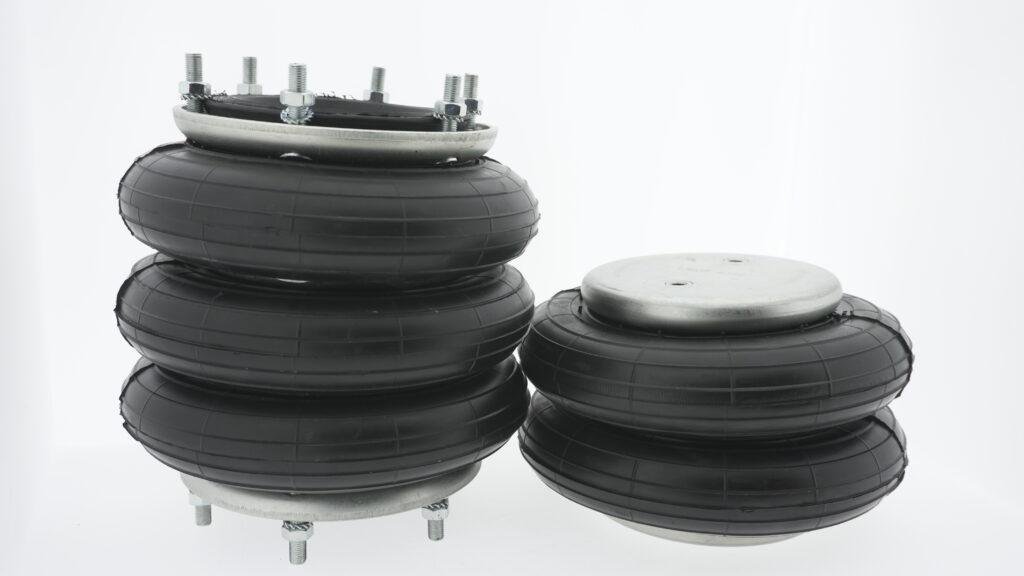
Reinforced structure for lasting support
The reason air bellows withstand heavy loads over long durations lies in their layered structural design. Each bellow integrates multiple fabric-reinforced rubber layers, which provide both flexibility and compressive strength. These layers distribute the axial forces uniformly across the bellow’s surface. Furthermore, steel bead rings and metal closures enhance resistance to deformation under sustained pressure. This structure absorbs load without compromising the cylindrical shape. The choice of high-performance elastomers, including nitrile, EPDM, and chloroprene, adds resilience against fatigue and aging. Consequently, the bellows retain their mechanical integrity throughout demanding load cycles. Additionally, the convolution shape ensures elasticity and energy dissipation under compression. This design prevents material fatigue and extends service life, even in high-pressure systems. Due to this, air bellows withstand heavy and fluctuating loads without loss of function or structural damage. This makes them ideal for consistent industrial usage where reliability over time is essential.
Elastomer compounds tailored for load endurance
To help air bellows withstand heavy pressure consistently, Oria uses optimized elastomer compounds in every design. Nitrile (NBR) offers resistance to oil and fuel, while EPDM provides thermal and ozone resilience. These properties are essential for load-bearing bellows subjected to harsh industrial environments. Furthermore, chloroprene delivers a balance between oil resistance and weather durability. By combining these compounds with reinforced textile plies, Oria ensures dimensional stability under long-term stress. This rubber-textile hybrid absorbs mechanical vibrations while resisting permanent deformation. Each material is carefully selected based on application temperature, chemical exposure, and required elasticity. As a result, each bellow maintains its performance even after thousands of compression cycles. Moreover, the compounds exhibit low compression set, meaning they return to original height after load release. This is one reason air bellows withstand heavy mechanical stress without losing form or effectiveness. The proper material selection is critical to ensuring durable, load-resistant air spring systems.
Metal components enhance structural strength
The metal parts used in Oria bellows also ensure air bellows withstand heavy operational demands. Depending on the model, these may include galvanized steel, aluminium, or AISI-304 stainless steel closures. These materials offer corrosion resistance and high rigidity. Dismountable and crimped configurations ensure tight sealing and easy integration into industrial machines. Furthermore, these components distribute axial forces evenly, preventing excessive compression at localized zones. By holding the rubber layers in precise alignment, they maintain the system’s geometry even under extreme loading. Moreover, designs with four-ply construction can handle pressures up to 12 bar, significantly extending performance thresholds. Because these metallic closures are engineered for structural retention, they help maintain system integrity over time. This guarantees that air bellows withstand heavy loads without compromising the safety or functionality of the application. Additionally, the compatibility with compressed air, nitrogen, and oil-based fluids makes them ideal for diverse operating environments.
Fatigue resistance through vibration isolation
One reason air bellows withstand heavy use over time is their innate vibration-damping capability. These bellows operate at a low natural frequency, reducing the risk of resonance and fatigue failure. By isolating vibrations from machinery, they minimize cyclic stress on both the bellow and surrounding components. Moreover, this prevents micro-tearing or cracking in the rubber structure. The bellows maintain a consistent load height thanks to their pressure-adjustable design. This stabilizes vertical alignment and reduces misalignment stress. Additionally, when used as vibration isolators, they eliminate more than 99% of transmitted noise and oscillation. This reduces long-term mechanical wear on mounting structures. As a result, air bellows withstand heavy dynamic loads without loss of vibration control. The fatigue resistance engineered into every bellow increases their longevity and reduces the need for maintenance or replacement. This performance makes them ideal for use in high-frequency industrial systems requiring 24/7 uptime.
Maintenance-free function in harsh conditions
An added advantage is that air bellows withstand heavy loads without needing regular maintenance. Their sealed, frictionless design eliminates points of failure common in metal springs or hydraulic cylinders. The rubber-fabric combination does not require lubrication and resists both corrosion and environmental degradation. These properties make the bellows suitable for use in dusty, wet, or chemically aggressive environments. Moreover, their non-metallic core components do not suffer from internal abrasion or fatigue cracks. Installation is simple, and once mounted, they require minimal oversight. Because there are no moving parts, operational costs are significantly lower over time. Additionally, they tolerate misalignments and lateral shifts without impacting performance. This adaptability prevents stress concentrations that would otherwise reduce lifespan. These benefits explain why air bellows withstand heavy and continuous operation without failure or excessive upkeep. The cost-efficiency and reliability of these units provide long-term value across industrial systems demanding robust load-handling solutions.
Proven performance in real-world industries
Real-world applications confirm that air bellows withstand heavy mechanical and environmental stresses with ease. Oria bellows are deployed in high-pressure industrial systems, including machine platforms, presses, and vibration-sensitive machinery. Field data shows sustained load capacity even in chemically aggressive or high-temperature settings. Continuous testing under cyclic loading, burst pressure, and deformation confirms the durability claims. Every unit is manufactured with adherence to international standards, ensuring consistent quality across production batches. Additionally, client feedback underscores long-term satisfaction with reliability, lifespan, and low maintenance requirements. Because of their tested performance, air bellows are preferred in installations requiring long service life and minimal downtime. Industries such as automation, material processing, and vibration damping rely on these bellows for continuous uptime. For all these reasons, air bellows withstand heavy loads while preserving performance over years of operation.
